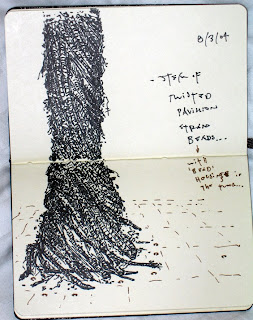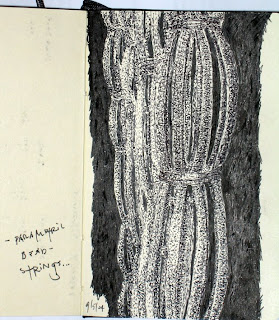Received this wonderful photo above from my friend Martin Bjorklund. It depicts him, on sea ice, in the archipelago by the Helsinki / Espoo border (in Finland). It's a unique picture also in how exposed the ice is, as usually the Winter's freezing temperatures are accompanied by snowfall, that very quickly covers the ice, result in skating becoming a bit more of a hassle.
 Snow covered trees
Snow covered trees(photo by Verna Bjorklund)
It reminded me (and as this blog is supposed to predominantly be about design related matters) about a (to date) 'paper' project I did a while back for a rest-stop pavilion focated in the shallow end of a Finnish lake or sea bay. The pavilion, made up of a set of assembled, but clearly distinguished, layers, aimed to use its context as a catalyst in its implementation by, for example, re-shaping the surface of the Winter ice to accommodate various textural (grip and orientation related) properties (see images below), as well as utilizing a, call it, bespoke 'bead-curtain' system that uses a variety of diverse types of beads to fulfil different needs.
 The manipulation of the ground surface (which in this
The manipulation of the ground surface (which in thisinstance is ice) to accommodate various functions
(this could be an opportunity to use RFP (Rapid
Freeze Prototyping) in an architectural context?)...
This is achieved by changing anything from a single bead (there are a number of different beads intended for different purposes) to a stand of beads, to a cluster of strands, to a bunch of clusters, depending on intention.
 Examples of different customizable beads...
Examples of different customizable beads... Examples of how the various beads can be combined into a set
Examples of how the various beads can be combined into a setof (bead) stands, which in turn can be combined into various
bead-strand clusers...
Each bead stand has a wire going through its centre (as bead-curtain strands do), and can be oriented in four different positions by twisting consecutive beads within their, clover-leaf shaped, male-female, connections (see images below).
 The four directions of a bead link...
The four directions of a bead link...
 The male-female 'four-leaf clover' connection...
The male-female 'four-leaf clover' connection...
 The four directions of a bead link...
The four directions of a bead link... The male-female 'four-leaf clover' connection...
The male-female 'four-leaf clover' connection... This allows, when applied to a whole strand, the various individual properites of the different beads to work in collusion with the other beads sandwiched on the same strand, thus providing the stand with a unique set-up (a bit like DNA) which can be very easily adjusted and adapted to perform a variety of assigned aims...
 A detail of a bead link on a stand.
A detail of a bead link on a stand.
 A detail of a bead link on a stand.
A detail of a bead link on a stand. When this set-up is applied in the pavilion, design a variety of different (context, climate) responsive settings can be achieved. These include 'furry' bead stands that during the Summer allow a stretch of pavilionbead-curtain wall to perform as 'regular' bead-curtains do, and allow a user to pass through, however in the Winter, the same furry beads collect and trap water that, as the weather gets colder, freeze into a solid and protective wall. Other beads have insulating qualities, or are adapted to be use as light reflectors, lanterns, or even seating (see images below)...
 The outer layer of 'furry' beads freeze
The outer layer of 'furry' beads freeze
in the winter to form a (wind-chill)
protective periphery for the pavilion...
 'Furry' bead-stand wall...
'Furry' bead-stand wall...
 The roof/ ceiling of the pavilion is predominantly
The roof/ ceiling of the pavilion is predominantly
exposed, allowing the sun to enter the space in the
Summer, but traps the snow in Winter to form
a protective layer against the climate...
 The outer layer of 'furry' beads freeze
The outer layer of 'furry' beads freezein the winter to form a (wind-chill)
protective periphery for the pavilion...
 'Furry' bead-stand wall...
'Furry' bead-stand wall...  The roof/ ceiling of the pavilion is predominantly
The roof/ ceiling of the pavilion is predominantlyexposed, allowing the sun to enter the space in the
Summer, but traps the snow in Winter to form
a protective layer against the climate...
The design was conceived as something which could use the existing RM (Rapid Manufacturing) technologies to its advantage, and a few prototype beads were fabricated through FDM, however, any design we make always involve a varied set of mediums, both old and new school, in their conception that inevitably influence the outcome. Below are some examples of the sketches made as a part of the design process.










No comments:
Post a Comment